Rotational Inertia Demonstrator
A useful classroom device to demonstrate the concepts of Rotational Inertia and Angular Momentum.
This rotational inertia demonstrator consists of a pivoted 2-wheel pulley system (6/13 cm diameter) with adjustable position weighted arm (27cm) and a fixed mount. The wheels are marked to aid the recording of rotations and have an adjustable plastic-sheathed screw to increase friction within the rotating system. This device is best used with a retort stand and clamp for classroom demonstration. It is useful to demonstrate the concepts of Rotational Inertia and Angular Momentum.
How does it work?
Angular momentum is a measure of a rotating object’s ability to keep spinning. The more angular momentum it has the longer it will keep spinning. Rotational inertia is a property of any object that can be rotated, to continue spinning at the same speed on an axis. The rotational inertia of a body depends on its mass.
A spinning/rotating body with a larger mass is harder to speed up or slow down than a spinning/rotating body with a smaller mass. The rotational inertia also depends on the distribution of that mass relative to the axis of rotation. When a mass moves further from the axis of rotation it becomes increasingly difficult to change the rotational velocity (speed) of the system. It is for this reason that a skater finds it harder to spin fast with arms out.
Adjusting the mass distribution (position of weight) along the connecting arm demonstrates how changes in the position of the weight close to or further away from the axis of rotation (the centre of the pulley wheels) affects the speed/velocity of the rotation and/or the number of times the rod/wheels spin.
There are 2 differently sized wheels/pulleys attached to the weighted arm. These can have a weighted string/belt (not included) placed over them to increase the experiment variables. If you place a weight on the smaller wheel (pulley) the system will rotate faster. If you place a weight on the larger wheel (pulley) the system will rotate slower. The system can be altered further by increasing the friction on the wheels by screwing down a plastic-sheathed screw.
A common example to explain angular momentum and rotational inertia is that of an ice skater. With arms out wide the skater spins relatively slowly on a point but by bringing their arms closer in to the body the skater can spin much faster. This action of bringing the arms in closer to the body decreases the rotational inertia but in compensation causes the spin to speed up due to the conservation of angular momentum.
| Length (cm) | 29 |
|---|---|
| Width (cm) | 12 |
| Height (cm) | 16 |
| Age Group | 12+ Years |





